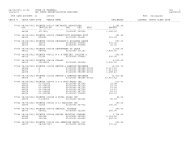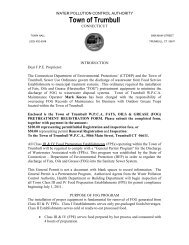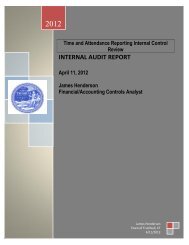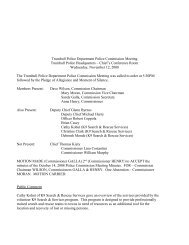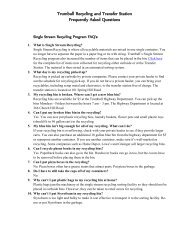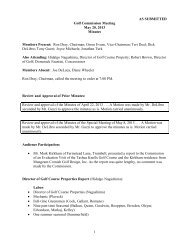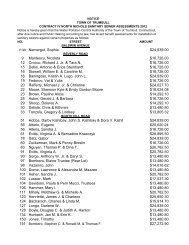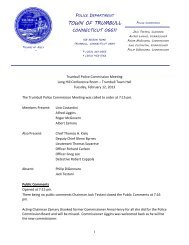Forensic Audit Report-WPCA Phase IV, Part B. Contract ... - Trumbull
Forensic Audit Report-WPCA Phase IV, Part B. Contract ... - Trumbull
Forensic Audit Report-WPCA Phase IV, Part B. Contract ... - Trumbull
Create successful ePaper yourself
Turn your PDF publications into a flip-book with our unique Google optimized e-Paper software.
<strong>Forensic</strong> Consulting Services <strong>Report</strong><br />
Town of <strong>Trumbull</strong>, Connecticut<br />
Page 26<br />
It should also be recognized that since there were no geotechnical investigations (i.e. borings,<br />
pavement cores, etc.) preformed and/or available for review during the bidding process for<br />
<strong>Contract</strong> 3, the contractors bidding the project had little or no documented assistance for<br />
anticipating pavement thicknesses. As a result it would be fair to say that the bidders most<br />
likely adjusted their prices accordingly to insure adequate compensation would be received<br />
should greater than minimum thicknesses were required. This along with the rather narrow<br />
pay limits for completing the trench restorations may account for the higher unit prices for<br />
Item No. 52.<br />
‣ In most cases, despite the lack of consistency with the above referenced detail, and therefore<br />
the contract requirements, it was reported that the “temporary pavement” placed during the<br />
initial trench paving operations was routinely accepted by the Town as the “permanent”<br />
pavement base as provided for and allowed under the provisions of Specification Section 4.3<br />
prior to application of the overlay surface course. As such, the Towns’ acceptance of a less<br />
than adequate “temporary” pavement as “permanent” may ultimately have been a major<br />
contributing factor to the significant amounts of “cracking” experienced in the overlay course<br />
on many project streets as reported and observed during site visits.<br />
“Permanent Pavement Overlay” Details<br />
The standard detail for “Permanent Pavement Overlay” delineated on Design Sheet D-1 indicates a<br />
6-foot wide gutter mill along the existing pavement edge (“as required by Town Engineer”) prior to<br />
the application of a full-width 1 ½-inch Class 2 wearing course. No gutter depths are indicated.<br />
Typically the purpose of a gutter mill is to reduce the thickness of the existing pavement thereby<br />
maintaining acceptable curb reveals and/or driveway matching once the overlay pavement course is<br />
applied. Gutter mills are also used as a means for establishing a cross-sectional crown to an existing<br />
roadway thereby shedding surface drainage towards the gutter.<br />
Based on our review, this element of the roadway restoration process was not used despite having<br />
such a specified provision, as well as a fairly attractive and established contractor unit price of $0.01<br />
per square yard. During interviews of Town representatives it was reported that the need for<br />
implementing the gutter milling process was not found necessary due to the existing condition of the<br />
roadways. In addition, it was stated that in many cases the gutter milling process was not used<br />
simply because of limited thicknesses of the existing pavement structure, thus any significant<br />
removal would have essentially removed most, if not all of the pavement base. It was also reported<br />
that the decision not to implement the gutter milling process was a general consensus between Town<br />
officials and the contractor based on the character of the existing roadways.<br />
“Gravel Access Drive” and “Grass Access Drive” Details<br />
Although both “Gravel Access Drive” and “Grass Access Drive” details were delineated on Design<br />
Sheet D-1 and were required as elements of the contract work for cross country applications, there<br />
were no pay items established within the original contract documents at the time of bid for the<br />
contractor to receive the appropriate compensation. The apparent lack of a designated Unit Price



